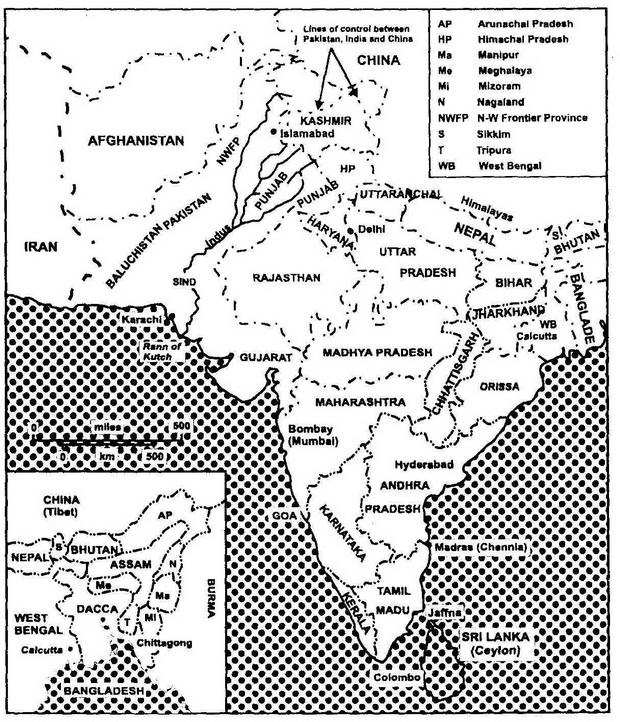Nagaland Geographical Importance
From villages perched high on the mountain ridges to either side of the valleys of Nagaland, Naga tribes people survey their separate
domains. Headhunters until not so long ago, the Nagas have long been feared and respected throughout the northeast, although in truth they are a warm and welcoming people. They seem originally to have lived in northeast Tibet, then moved through southwest China into Burma, Malaya and Indonesia, as well as eastern Assam. In Nagaland, they can be divided into sixteen main groups, including
the Angamis around Kohima, the Konyaks, Ao, Lothas, Semas and Wanchus. Despite their fierce reputation, all are essentially farmers who cultivate terraced fields and tend cattle.

The British administrators of Nagaland who arrived at a truce with the Nagas towards the end of the nineteenth century, agreed not to penetrate beyond certain boundaries, so their maps left numerous blank areas. Based in the Angami village of Kohima, the Deputy Commissioner occasionally toured the territories to collect taxes and administer justice and came to hold a certain authority among the various tribes. Some developed a loyalty to the British, others saw them as intruders. In 1879 loyal Kohima Angamis who helped to smuggle a message through to British lines in the Assam Valley relieved the Khonoma Angami rebellion against Kohima through assistance. When the Indian flag replaced the Union flag in 1947, it was promptly removed by Nagas, who had come to accept the British presence (Crown Colony) but did not want to join India. For many years, the Naga National Council (NNC) under Angami Zapu Phizo, and with Chinese fought a bitter war for Naga independence. In 1974, a section of it broke away and, as the United Democratic Front, won election to the state government, then signed the Shillong Accord and laid down their arms. But the rump of the NNC fought on, splitting in 1980 when Plizo’s lieutenant, Thuingaleng Muivah, lshak Chishi Swu and SS Khaplang broke away to form the National Socialist Council of Nagaland (NSCN), again in 1988 they divided into two faction naming as NSCN(K) and NSCN(IM) . SS Khaplang faction is still fighting to this day but with one year ceasefire l-M group has now come to negotiation process with Indian government.
In 1993, Nagaland experienced recrudescent violence as two ethnic groups, the Nagas and the Kukis, engaged in brutal conflict with each other. Adding to India’s internal unrest in this region were the links established between the Bodo insurgents in Assam and the National Socialist Council of Nagaland, which, in turn, had links to other active insurgent groups and, reportedly, operatives in Thailand.
On August 1, 1997, a ceasefire between the Government and the ISAC-Muivah faction of the NSCN (NSCN-IM) went into effect and has been largely observed by the Government and all insurgent groups in the state. However, factional feuds among rival Naga insurgent groups claimed an estimated 120 lives during the first 3 months of the ceasefire. The Government extended the ceasefire for another 3 months on November 1, unilaterally including even those armed groups in Nagaland which had not been party to the original ceasefire.
During the latter part of the year, the cease-fire was extended through July 31, 2000. In May 1999, underground Naga leaders Isak Chisi Swu and Thuingaleng Muivah, chairman and general secretary respectively of the NSCM-lM, visited Nagaland for the first time in 33 years. The Government asked the NSCM-IM to define the geographical boundary of “Nagalim’ to enable it to extend the cease-fire zone to these areas. On August 18, the NSCM-lM killed Daily Mungro, general secretary of the Khaplang faction of the NSCN, along with two of his associates.
The ceasefire was extended in January 2000 until July 31, 2001. In April another Naga insurgent group, the National Socialist Council of Nagaland-Khaplang (NSCN-K) -- the arch rival of NSCN (l-M) -- announced a formal ceasefire. Security forces were not operating against either of the two NSCN factions and both generally were observing the ceasefire with security forces. However, in April 2001 week-long fighting between the 2 NSCN factions left over 45 persons dead, and 4,500 persons were forced to flee 15 villages in Mon district. Negotiations to widen the area of application of the ceasefire were handicapped when NSCN(I-M) leader Thuingaleng Muivah was arrested in Thailand on January 19 for travelling on a forged South Korean passport. On August 25, a joint group of Thai and Indian citizens appealed to the central Government to secure the release of the NSCN(IM) leader in the interest of Naga peace talks. He was released on bail in September 2001.
Insurgent Groups
NSCN-IM: The [National Socialist Council of Nagaland—] was formed in 1980 to establish a Greater Nagaland, encompassing parts of Manipur, Nagaland, North Cachar Hills (Assam).The NSCN split in 1988to form two groups namely NSCN(IM) & NSCN(K). As of ncw both the groups are in ceasefire with the Govt of India, however are actively involved in illegal activities like extortion, kidnapping, inter factional clashes, boot legging, recruitment of cadres etc.
NSCN-K: The National Socialist Council of Nagaland—Khapiang is the second faction with the same aim of a Greater Nagaland and was formed in 1988.
|